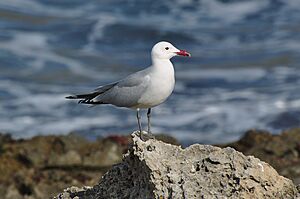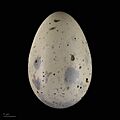Audouin's gull facts for kids
Quick facts for kids Audouin's gull |
|
|---|---|
 |
|
| Conservation status | |
| Scientific classification | |
| Genus: |
Ichthyaetus
|
| Species: |
audouinii
|
| Synonyms | |
|
Larus audouinii |
|
The Audouin's gull (scientific name: Ichthyaetus audouinii) is a special type of large gull. You can mostly find it around the Mediterranean Sea, and along the western coasts of Saharan Africa and the Iberian Peninsula (which includes Spain and Portugal).
Its scientific name, Ichthyaetus, comes from two Ancient Greek words: ikhthus, meaning "fish", and aetos, meaning "eagle". This name hints at its diet! The specific name audouinii and its English name honor a French scientist named Jean Victoire Audouin.
Contents
About Audouin's Gull
Audouin's gulls like to breed on small islands. They often nest together in groups, called colonies, but sometimes they nest alone. Each pair usually lays 2 to 3 eggs in a nest built right on the ground.
A Rare Bird
Not long ago, in the late 1960s, the Audouin's gull was one of the rarest gulls in the world. There were only about 1,000 breeding pairs left. But thanks to conservation efforts, their numbers have grown! Today, there are around 10,000 pairs. Even with this increase, they are still considered a rare bird.
What They Eat
Unlike many other large gulls that might eat almost anything, Audouin's gulls are picky eaters. They are special because they mostly eat fish. This means they stick close to the coast and open sea. They often hunt for fish at night, sometimes far out at sea. They also fly slowly near beaches, sometimes dipping their legs into the water to help them slow down.
How to Spot One
An adult Audouin's gull looks a bit like a smaller European herring gull. But there are a few key differences to help you tell them apart:
- They have a short, thick, red beak.
- Their wingtips have white spots that look like a "string of pearls." Other gulls might have larger white patches, called "mirrors."
- Their legs are a grey-green color.
It takes about four years for a young Audouin's gull to get its full adult feathers and colors.
Where They Travel
Audouin's gulls usually stay close to their breeding areas. They don't tend to wander far. However, there have been a few rare sightings in other places. For example, one was seen in the Netherlands and England in May 2003. Another spent several months in Trinidad from December 2016 to April 2017.
Protecting the Species
The Audouin's gull is an important bird that is part of an agreement called the Agreement on the Conservation of African-Eurasian Migratory Waterbirds (AEWA). This agreement helps protect birds that migrate (travel) across Africa and Eurasia.
Gallery





